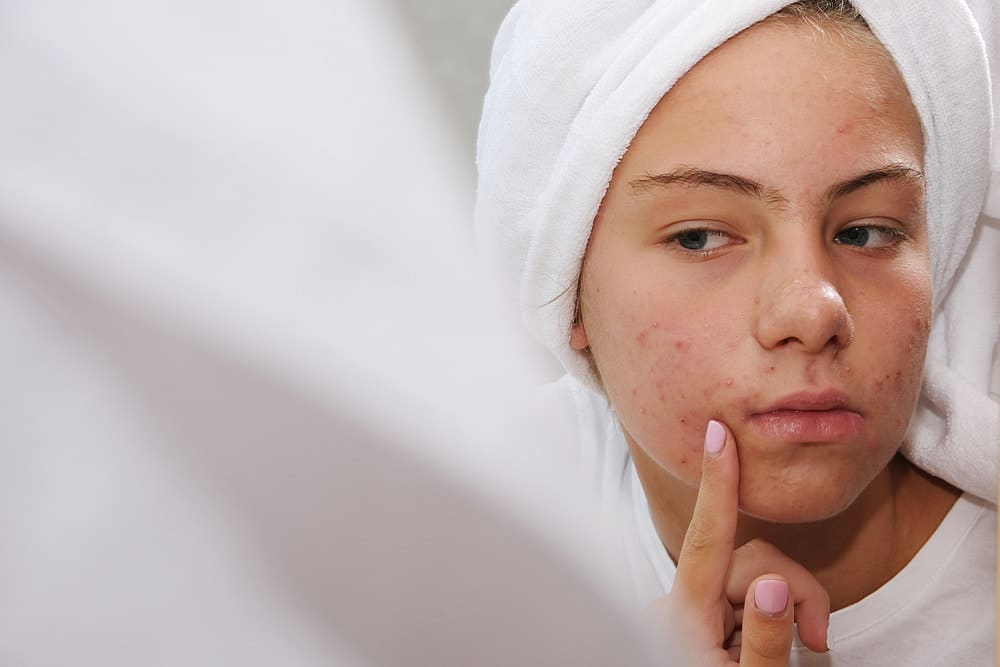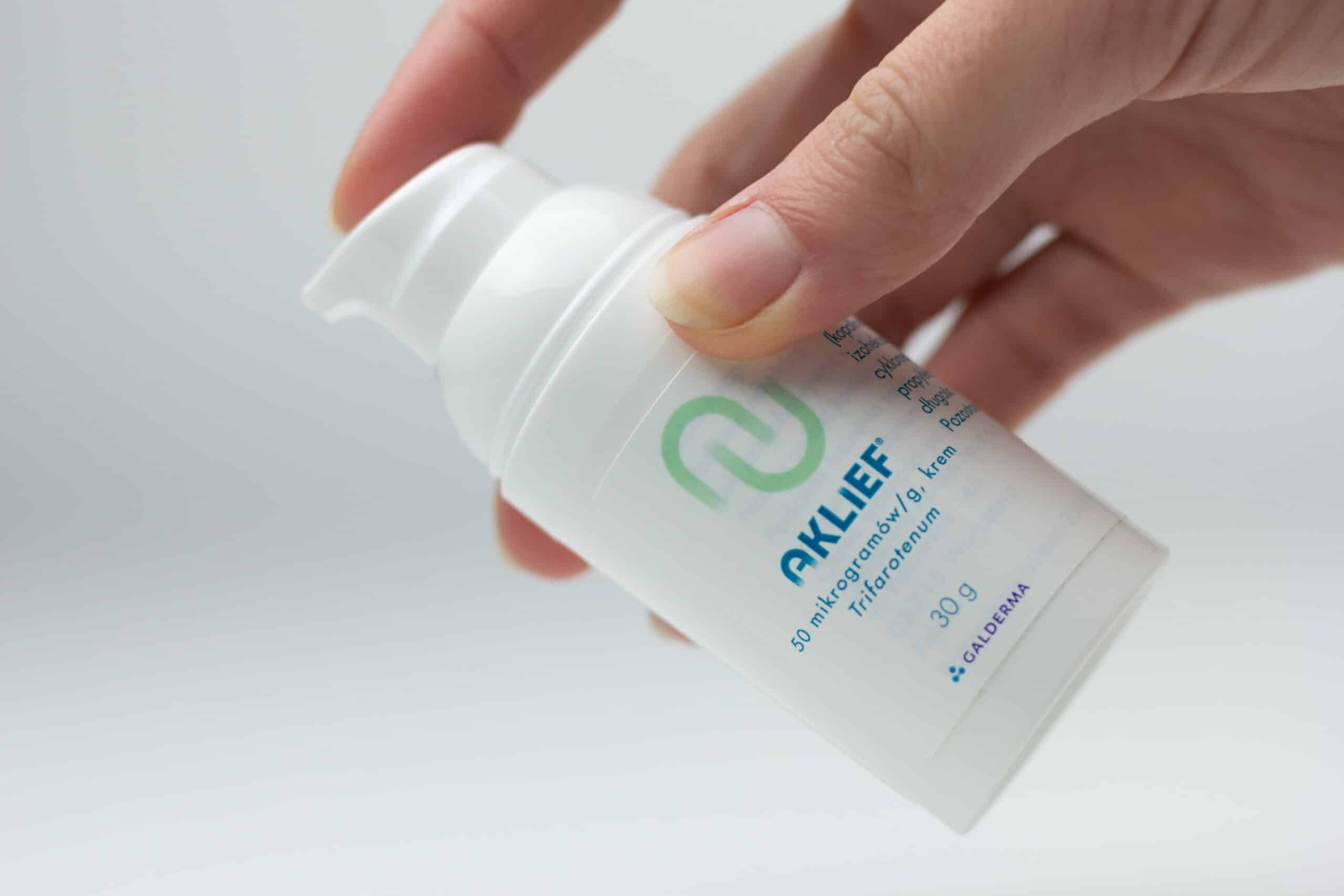
Guide to Trifarotene (Aklief) Acne Treatment: Benefits, Uses, How it Works
- September 7, 2023


Acne be gone! A new and exciting topical acne treatment has recently been approved for use in Singapore, so let’s find out why so many people are talking about it! .
This powerful acne-fighting ingredient is none other than trifarotene, also known by its brand name Aklief. This comprehensive guide will explore what trifarotene is, how it helps with acne treatment, its comparison to other retinoids, and the results you can expect.
Trifarotene is a recently approved fourth-generation retinoid for topical acne treatment on the face, chest and back. Compared to older retinoids, trifarotene has a greater affinity and selectiveness for RAR-gamma receptors in the skin cells. This means that a small amount goes a long way.
The biggest breakthrough in this fourth-generation retinoid is its effectiveness in treating truncal acne, or bacne. This refers to acne on the chest and back. Prior to trifarotene, topical treatment of bacne using older generations of retinoids has often been met with little success. You can find trifarotene as a gel or cream and apply it to the affected areas of your skin. It is usually applied once a day.
Trifarotene targets the root causes of acne by regulating the abnormal growth of skin cells and reducing inflammation.
When you apply trifarotene to your skin, it helps to prevent clogged pores by promoting the turnover of skin cells. Including trifarotene in your acne treatment means dead skin is less likely to build up and cause breakouts. Trifarotene also reduces sebum production, which can contribute to acne.
Two 12-week studies have shown that trifarotene effectively reduces inflamed and non-inflamed acne on both the face and trunk. In fact, trifarotene managed to decrease inflammatory acne by up to 66%!
Non-inflammatory acne includes blackheads and whiteheads, and is caused by clogged pores and the buildup of dead skin cells, oil, and bacteria. Inflammatory acne, on the other hand, includes red, swollen pimples and cystic acne, and is contributed by bacteria and inflammation within the pores.
Trifarotene’s role in preventing acne scars works in two ways. Firstly, by reducing the number of active pimples, the overall risk of scarring decreases because every pimple is a potential scar in the making. Secondly, trifarotene downregulates matrix metalloprotineases (MMPs), which helps prevent acne scar formation during the healing phase.
One key advantage of trifarotene over other retinoids is that it is designed to be more selective in targeting the skin. It focuses specifically on the RAR-gamme receptors in the skin that are involved in acne development.
This selective targeting reduces the potential for skin irritation, such as dryness and peeling, compared to other retinoids. If you have sensitive skin, trifarotene is a better acne treatment option for you.
Truncal acne can be particularly challenging to manage due to the thicker skin in these areas. Trifarotene can penetrate thicker skin such as those on the back, addressing acne lesions and improving skin texture and overall appearance of the chest, back, and shoulders.
Similar to other retinoids, trifarotene may also help with removing pigmentation, treatment of fine wrinkles, and skin renewal.
You should follow your doctor’s instructions on incorporating trifarotene (Aklief) into your skincare routine. Usually, you’ll apply it once a day in the evening because sunlight can make it less effective and cause skin sensitivity.
Here’s how to use trifarotene for acne removal:
By following these simple steps, you can maximise its benefits for treating acne.
Note: Trifarotene is designed to be applied topically to the breakout areas of the skin, such as your forehead, cheeks, nose, and chin. Using it on the entire face is unnecessary.
Trifarotene is generally safe, but like any medication, it has some potential risks and side effects.
The most common side effect of trifarotene is mild skin irritation, including redness, dryness, itching, or a burning sensation at the application site. This irritation is temporary and usually occurs during the first couple of weeks of starting trifarotene. It improves over time as your skin adjusts to the medication.
Trifarotene can increase your skin’s sensitivity to the sun, making it more prone to sunburn. Using sun protection measures, such as applying broad spectrum sunscreen with adequate SPF and wearing protective clothing is necessary.
Trifarotene may cause skin dryness, especially during the initial stages of acne treatment in Singapore. It is recommended to moisturise your skin regularly to help alleviate dryness.
Trifarotene’s ability to promote skin cell turnover may lead to increased exfoliation, which can cause temporary flaking or peeling of the skin. This effect can be managed by adjusting the frequency and amount of product used or by incorporating gentle exfoliation methods as your doctor advises.
While the increased skin turnover can cause exfoliation, it may also result in purging, as sebum and clogged pores are quickly being brought to the surface from deep within your skin. This is often temporary, and usually lasts for a month or so.
Although rare, some individuals may experience allergic reactions to trifarotene. If you develop severe itching, rash, swelling, or difficulty breathing, seek immediate medical attention.
Trifarotene can be used as a monotherapy or in combination with other treatment modalities. During your trifarotene acne treatment, you should avoid using other topical products that can irritate your skin, as your skin may become a bit more sensitive. You will also need to cut down or stop other treatments that cause exfoliation, such as chemical peels..
Oral medications like doxycycline may be prescribed alongside topical trifarotene. Oral medications can provide systemic benefits and help manage acne from within the body. Under medical supervision, combining them with trifarotene can offer a comprehensive approach to treat severe or stubborn acne cases.
Even when your skin is cleared of acne after trifarotene treatment, it can still be used for long-term maintenance. Trifarotene helps prevent future acne breakouts and maintains clear skin.
If your doctor does prescribe Aklief for extended use, here are some things to take note of:
The specific duration of long-term use and how often you should use it may vary depending on individual factors. It is best to consult your doctor to determine the most appropriate long-term treatment plan.
During maintenance treatment, your doctor may recommend adjusting the frequency of application or using a lower concentration of trifarotene. They will monitor your progress, assess your skin’s response, and make any necessary adjustments to ensure optimal results.
Skincare routines can evolve, and what may work as a maintenance treatment initially may need to be modified as your skin changes or adapts. Regular follow-up appointments with your doctor are essential to evaluate the ongoing effectiveness of the treatment.
According to Singapore’s Health Sciences Authority (HSA), trifarotene can be used by individuals 12 years and above who are seeking treatment for acne. It is typically prescribed to adolescents and adults with mild to moderate acne.
The HSA approved AKLIEF Cream as a prescription acne medication in 2022. Trifarotene is the active ingredient in AKLIEF Cream.
Trifarotene is generally suitable for various skin types, including oily, dry, and sensitive skin.
However, it’s essential to consult with a doctor who can evaluate your specific skin condition and determine if trifarotene is the right choice for you. They will consider factors such as your skin’s sensitivity and existing skin conditions to provide personalised advice.
If you are pregnant or breastfeeding, it is essential to discuss the use of trifarotene with your doctor. While trifarotene is a topical medication and only a tiny amount is absorbed into the bloodstream, its safety during pregnancy and breastfeeding has not been extensively studied.
It’s best to consult your healthcare provider, who can weigh the potential risks and benefits and discuss them with you..
The timeline for seeing results with trifarotene can vary from person to person. Having realistic expectations and understanding that acne treatment takes time are essential. Generally, it may take several weeks to a few months of consistent use before improvements become noticeable.
Trifarotene is not known to cause skin discolouration as a common side effect. It helps improve skin tone and texture over time. However, it’s important to note that individual reactions to any medication can vary.
During the course of treatment, it is also possible for other factors not related to trifarotene to cause discolouration.If you have concerns about skin discolouration, discuss them with your doctor, who can provide further clarification based on your specific skin type and medical history.
Trifarotene can generally be used on sensitive areas of the skin. However, it’s essential to be cautious and follow the guidance of your doctor. They may recommend starting with a lower concentration of trifarotene or adjusting the frequency of application to minimise the potential for skin irritation.
If you experience excessive irritation or discomfort, you must inform your doctor, who can provide further recommendations.
No. It’s given through prescription only.
Both work through slightly different mechanisms and one isn’t necessarily stronger than the other. Trifarotene, however, is designed to be more specific in targeting RAR-gamma receptors, which makes the side effects more tolerable than tretinoin.
No. One major difference is that differin can be obtained without a doctor’s prescription, unlike Aklief.
Trifarotene can be an effective solution for acne, significantly improving symptoms and helping you achieve the clear, radiant complexion you desire.
If you’re frustrated with your acne and seeking a practical solution, consider consulting with SL Aesthetic. Our experienced doctors can evaluate your skin condition, determine if trifarotene suits you, and create a personalised treatment plan tailored to your needs.
Make an appointment with us today.
Like what you read? Share them!